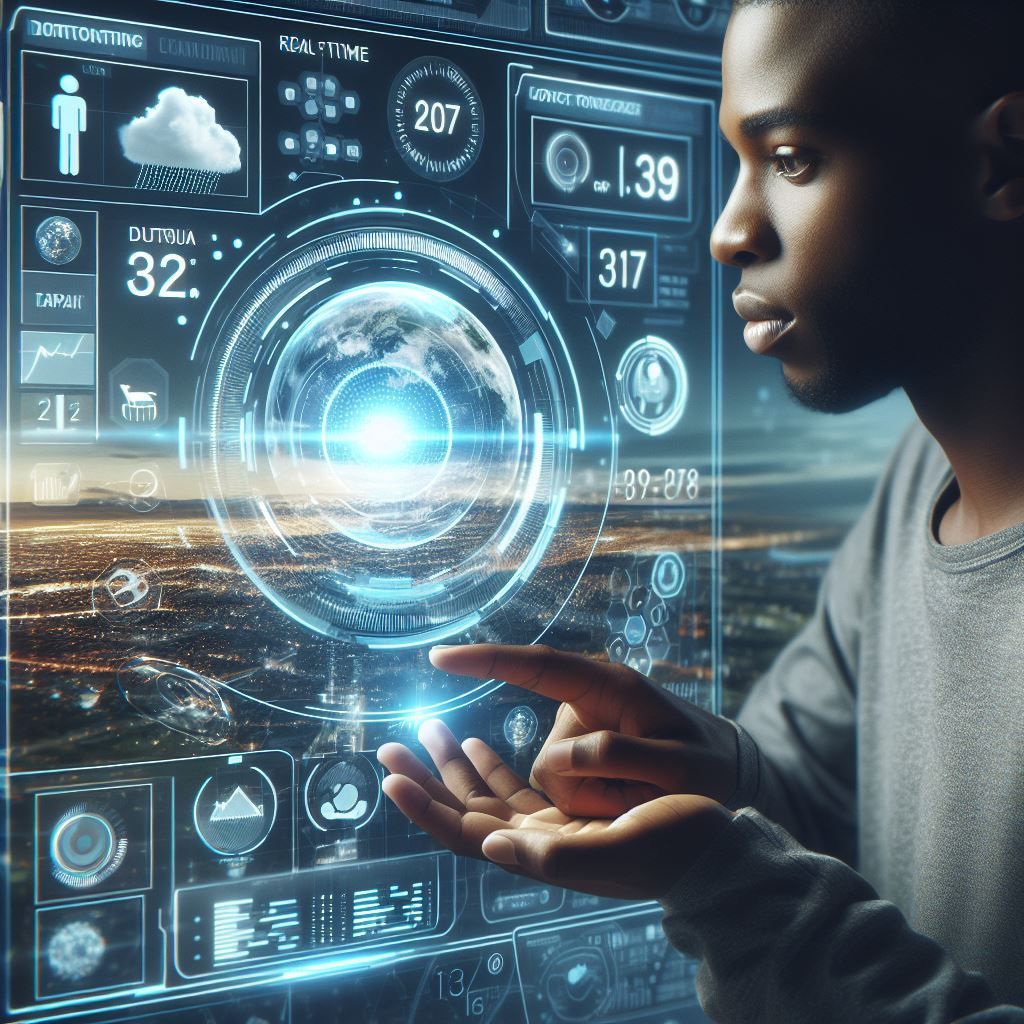Rain or Shine, AI Knows! ☔☀️ Unleashing the Power of AI-Powered Weather Forecasting.
Ditch the guesswork & embrace the future! Explore how AI algorithms analyze vast data, predict weather patterns like never before, & empower you with informed decisions.
For centuries, humans have gazed at the sky, interpreting clouds and wind patterns to predict the weather. While our methods have evolved from reading tea leaves to sophisticated weather balloons, forecasting remains an imperfect science. But a new player is entering the arena: Artificial Intelligence (AI).
With its ability to analyze vast amounts of data and learn from complex patterns, AI is revolutionizing the way we predict the weather.
This blog post delves into the exciting world of AI-powered weather forecasting, exploring its potential to transform our understanding of the skies and how we prepare for the elements it throws our way.
The Challenges of Weather Forecasting

Traditionally, weather forecasts rely on complex mathematical models that simulate atmospheric processes.
These models require enormous computing power and struggle to capture the intricate interactions between different atmospheric variables.
Additionally, initial data inaccuracies can cascade through the model, leading to significant errors in the final forecast.
What is AI-Powered Weather Forecasting?

AI-powered weather forecasting is a revolutionary approach to predicting weather conditions that leverages the power of artificial intelligence (AI) and machine learning. Here’s a breakdown of how it works and why it’s changing the game:
How AI Transforms Weather Forecasting
- Massive Data Handling: AI excels at analyzing vast and complex datasets far beyond what humans can manage. Weather forecasting involves huge amounts of data from sources like:
- Satellites: Images of cloud cover, temperature gradients, etc.
- Weather Stations: Temperature, humidity, air pressure, wind data, and more.
- Radar: Tracks precipitation and storm movement.
- Ocean Buoys: Measure sea surface temperatures, currents, etc.
- Sophisticated Pattern Recognition: AI algorithms are trained on massive amounts of historical weather data. They learn to identify subtle patterns and relationships that might be invisible to traditional forecasting methods. This leads to more accurate predictions across different time scales.
- Faster Predictions: Powerful AI systems can process information and generate forecasts in a fraction of the time traditional supercomputer-based models need. This is crucial for timely warnings about severe weather events.
- Hyperlocal Precision: AI can tailor forecasts to very specific locations by incorporating highly granular geographic data. This benefits industries and individuals whose decisions are heavily impacted by localized weather.
Key Benefits of AI-Powered Weather Forecasting
- Accuracy: AI-powered forecasting outperforms many traditional methods, leading to better predictions of rain, snow, temperature changes, and extreme events.
- Speed: Rapid forecasts support swift decision-making, especially critical in disaster preparedness and risk management.
- Detail: High-resolution forecasts provide granular information for hyperlocal planning and optimization of weather-dependent operations.
- Adaptability: AI models can continuously learn from new data, improving their ability to handle changing weather patterns and climate trends.
In short, AI-powered weather forecasting delivers a quantum leap in accuracy, speed, and personalization, transforming how we predict and prepare for the weather around us.
The AI Advantage: Learning from the Past, Predicting the Future

AI approaches overcome these limitations by learning from vast historical weather data.
This data includes observations from satellites, weather stations, and even social media reports. By analyzing these patterns, AI algorithms can identify subtle relationships between different variables that traditional models might miss.
Several AI techniques are used in weather forecasting:
- Machine learning: Algorithms learn from historical data to identify patterns and relationships between different variables, allowing them to predict future weather events with greater accuracy.
- Deep learning: Complex neural networks mimic the human brain, processing massive amounts of data to uncover hidden patterns and make more sophisticated predictions.
- Ensemble learning: Combining predictions from multiple AI models can improve accuracy and reduce the risk of overfitting to specific datasets.
Real-World Applications of AI Weather Forecasting

The potential applications of AI in weather forecasting are vast and already impacting various sectors:
- Improved short-term forecasts: AI models can predict hyperlocal weather events like thunderstorms or flash floods with greater accuracy and lead time, allowing for better preparedness and risk mitigation.
- Enhanced long-term forecasts: AI can analyze historical data and climate patterns to predict potential droughts, heatwaves, or other extreme weather events, enabling proactive planning and resource allocation.
- Personalized forecasts: AI can tailor weather forecasts to individual needs, providing farmers with optimal irrigation timing or alerting allergy sufferers to pollen levels.
- Aviation safety: AI can predict turbulence and other hazardous weather conditions, allowing airlines to optimize flight routes and improve passenger safety.
- Renewable energy integration: AI can predict wind and solar power generation, helping energy grids integrate renewable sources more efficiently.
How To Monetization AI-Powered Weather Opportunities

AI-powered weather forecasting offers a wealth of exciting monetization opportunities. Here’s a breakdown of the most promising avenues:
1. Specialized and Hyperlocal Forecasting
- Target Industries: Agriculture, construction, aviation, shipping, energy (especially renewables), event planning, and outdoor recreation benefit immensely from precise, localized weather data.
- Monetization: Offer subscription-based services tailored to these industries. Provide highly granular forecasts, alerts for critical weather events, and tools that help them optimize operations and minimize weather-related risk.
2. Enhanced Decision-Making Tools
- Target Audiences: Businesses across sectors need to make weather-sensitive decisions.
- Monetization: Develop AI models that analyze historical weather patterns alongside other data points (sales figures, supply chain info, etc.). Offer a platform that translates forecasts into actionable business insights, helping companies improve inventory management, route optimization, resource allocation, and marketing strategies.
3. Premium Consumer Weather Services
- Target Audience: Individuals who want more than generic weather apps provide. Think hobbyists (sailors, gardeners), people with weather-sensitive health conditions, and those seeking highly-tailored recommendations.
- Monetization:
- Tiered subscription models with basic info for free, and more precise forecasts, historical analytics, and personalized recommendations as paid features.
- Partnerships with outdoor gear companies or event ticketing platforms to provide weather insights relevant to user activities.
4. API Integrations
- Target Audience: Developers and businesses looking for accurate weather data.
- Monetization: Provide an API that seamlessly integrates your AI-powered weather forecasts into other applications and platforms. Charge per API call or on a subscription basis depending on volume.
5. Government and Research Collaboration
- Opportunities: AI can improve severe weather warnings, climate modeling, and disaster preparedness.
- Monetization:
- Partner with government agencies and research institutions on projects, receiving grants or contracts.
- License your technology for their use.
Important Considerations
- Accuracy is Paramount: The success of any AI-powered weather service hinges on the reliability and precision of your forecasts.
- Data is Key: Access to high-quality weather data is essential. Partner with data providers or invest in your own weather sensor network.
- Marketing and Partnerships: Collaborating with established weather services or niche industry players can expand your reach.
The Future of AI-Powered Weather

The field of AI-powered weather forecasting is still evolving, but its potential is undeniable. As AI algorithms become more sophisticated and data becomes more readily available, we can expect:
- Even more accurate and localized forecasts: Imagine knowing the exact timing and intensity of a downpour at your doorstep or predicting the chance of a specific crop-damaging weather event in your region.
- Improved disaster preparedness: Earlier and more accurate warnings of extreme weather events can save lives and property by enabling timely evacuations and resource mobilization.
- A deeper understanding of climate change: AI can analyze vast climate datasets to help us understand the complex mechanisms driving climate change and predict its future impacts.
Challenges and Considerations of. AI-powered Weather Forecasting
While AI holds immense promise, it’s essential to acknowledge potential challenges:
- Data bias: AI models are only as good as the data they train on. Biases in the data can lead to inaccurate or discriminatory forecasts.
- Explainability and trust: Understanding how AI models arrive at their predictions is crucial for building trust and ensuring responsible use.
- Accessibility and equity: Ensuring everyone has access to accurate weather information, regardless of their location or resources, is critical.
Conclusion: AI-Powered Weather Forecasting
AI is revolutionizing weather forecasting, offering a glimpse into a future where we can predict the weather with unprecedented accuracy and granularity.
By addressing potential challenges and ensuring responsible development, we can harness the power of AI to create a safer, more resilient, and weather-aware world for all.
Discover more from Digital Wealth Guru
Subscribe to get the latest posts sent to your email.








Comments